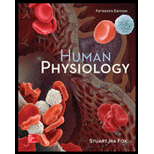
Human Physiology
15th Edition
ISBN: 9781259864629
Author: Fox, Stuart Ira
Publisher: Mcgraw-hill Education,
expand_more
expand_more
format_list_bulleted
Concept explainers
Question
Chapter 2, Problem 27RA
Summary Introduction
To review:-
The molecular weight of water (H2O) and glucose (C6H12O6)
Introduction:
Molecular weight or molar mass is the total mass of a molecule. Molar mass does not depend on the size of the molecule of any sample and is an intensive property of the substance. The International System of Units (SI) of molar mass is kg/mol (kilogram per mole) but it is generally represented in g/mol (gram per mole).
Expert Solution & Answer
Want to see the full answer?
Check out a sample textbook solution
Students have asked these similar questions
glg 112 mid unit assignment Identifying melting processes
Give only the mode of inheritance consistent with all three pedigrees and only two reasons that support this, nothing more, (it shouldn't take too long)
O
Chapter 2 Solutions
Human Physiology
Ch. 2 - List the components of an atom and explain how...Ch. 2 - Describe the nature of nonpolar and polar covalent...Ch. 2 - Define the terms acidic, basic, acid, and base....Ch. 2 - Using chemical equations, explain how bicarbonate...Ch. 2 - Prob. 4CPCh. 2 - Describe the structural characteristic of all...Ch. 2 - Describe the characteristics of a lipid, and...Ch. 2 - Explain, in terms of dehydration synthesis and...Ch. 2 - Relate the functions of phospholipids to their...Ch. 2 - Write the general formula for an amino acid, and...
Ch. 2 - Describe and account for the different levels of...Ch. 2 - Describe the different categories of protein...Ch. 2 - Prob. 10aCPCh. 2 - Prob. 10bCPCh. 2 - Describe the structure of DNA, and explain the law...Ch. 2 - Which of these statements about atoms is true?...Ch. 2 - The bond between oxygen and hydrogen in a water...Ch. 2 - Which of these is a nonpolar covalent bond?...Ch. 2 - Solution A has a pH of 2, and solution B has a pH...Ch. 2 - Glucose is
Ch. 2 - Digestion reactions occur by means of...Ch. 2 - Carbohydrates are stored in the liver and muscles...Ch. 2 - Lecithin is
Ch. 2 - Which of these Lipids have regulatory roles in the...Ch. 2 - The tertiary structure of a protein is directly...Ch. 2 - The type of bond formed between two molecules of...Ch. 2 - The carbon-to-nitrogen bond that joins amino acids...Ch. 2 - Prob. 13RACh. 2 - Prob. 14RACh. 2 - Prob. 15RACh. 2 - Prob. 16RACh. 2 - Prob. 17RACh. 2 - Explain, in terms of dehydration synthesis and...Ch. 2 - Prob. 19RACh. 2 - Prob. 20RACh. 2 - Explain how one DNA molecule serves as a template...Ch. 2 - Prob. 22RACh. 2 - Prob. 23RACh. 2 - From the ingredients listed on a food wrapper, it...Ch. 2 - Prob. 25RACh. 2 - Prob. 26RACh. 2 - Prob. 27RACh. 2 - Prob. 28RACh. 2 - Prob. 29RACh. 2 - The molecular weight is the sum of the atomic...
Knowledge Booster
Learn more about
Need a deep-dive on the concept behind this application? Look no further. Learn more about this topic, biology and related others by exploring similar questions and additional content below.Similar questions
- Describe the principle of homeostasis.arrow_forwardExplain how the hormones of the glands listed below travel around the body to target organs and tissues : Pituitary gland Hypothalamus Thyroid Parathyroid Adrenal Pineal Pancreas(islets of langerhans) Gonads (testes and ovaries) Placentaarrow_forwardWhat are the functions of the hormones produced in the glands listed below: Pituitary gland Hypothalamus Thyroid Parathyroid Adrenal Pineal Pancreas(islets of langerhans) Gonads (testes and ovaries) Placentaarrow_forward
- Describe the hormones produced in the glands listed below: Pituitary gland Hypothalamus Thyroid Parathyroid Adrenal Pineal Pancreas(islets of langerhans) Gonads (testes and ovaries) Placentaarrow_forwardPlease help me calculate drug dosage from the following information: Patient weight: 35 pounds, so 15.9 kilograms (got this by dividing 35 pounds by 2.2 kilograms) Drug dose: 0.05mg/kg Drug concentration: 2mg/mLarrow_forwardA 25-year-old woman presents to the emergency department with a 2-day history of fever, chills, severe headache, and confusion. She recently returned from a trip to sub-Saharan Africa, where she did not take malaria prophylaxis. On examination, she is febrile (39.8°C/103.6°F) and hypotensive. Laboratory studies reveal hemoglobin of 8.0 g/dL, platelet count of 50,000/μL, and evidence of hemoglobinuria. A peripheral blood smear shows ring forms and banana-shaped gametocytes. Which of the following Plasmodium species is most likely responsible for her severe symptoms? A. Plasmodium vivax B. Plasmodium ovale C. Plasmodium malariae D. Plasmodium falciparumarrow_forward
- please fill in missing parts , thank youarrow_forwardplease draw in the answers, thank youarrow_forwarda. On this first grid, assume that the DNA and RNA templates are read left to right. DNA DNA mRNA codon tRNA anticodon polypeptide _strand strand C с A T G A U G C A TRP b. Now do this AGAIN assuming that the DNA and RNA templates are read right to left. DNA DNA strand strand C mRNA codon tRNA anticodon polypeptide 0 A T G A U G с A TRParrow_forward
arrow_back_ios
SEE MORE QUESTIONS
arrow_forward_ios
Recommended textbooks for you
 Human Biology (MindTap Course List)BiologyISBN:9781305112100Author:Cecie Starr, Beverly McMillanPublisher:Cengage Learning
Human Biology (MindTap Course List)BiologyISBN:9781305112100Author:Cecie Starr, Beverly McMillanPublisher:Cengage Learning
 Biology Today and Tomorrow without Physiology (Mi...BiologyISBN:9781305117396Author:Cecie Starr, Christine Evers, Lisa StarrPublisher:Cengage Learning
Biology Today and Tomorrow without Physiology (Mi...BiologyISBN:9781305117396Author:Cecie Starr, Christine Evers, Lisa StarrPublisher:Cengage Learning


Human Biology (MindTap Course List)
Biology
ISBN:9781305112100
Author:Cecie Starr, Beverly McMillan
Publisher:Cengage Learning



Biology Today and Tomorrow without Physiology (Mi...
Biology
ISBN:9781305117396
Author:Cecie Starr, Christine Evers, Lisa Starr
Publisher:Cengage Learning

Macromolecules | Classes and Functions; Author: 2 Minute Classroom;https://www.youtube.com/watch?v=V5hhrDFo8Vk;License: Standard youtube license